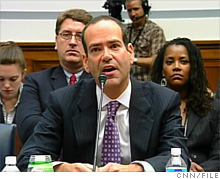Bailout cop: Treasury set 'unrealistic expectations'
Barofsky, reviewing the first big bailouts to 9 firms, concludes that the government was too rosy to the public about the banks' health.
 |
| Bailout inspector general says Treasury painted too rosy a picture of bailout firms. |
WASHINGTON (CNNMoney.com) -- A government watchdog says federal officials weren't entirely honest with the public about the health of the first 9 financial firms that got federal bailouts, according to a report released Monday.
Bailout special inspector general Neil Barofsky says in an audit that Treasury Department officials painted an overly rosy picture, creating "unrealistic expectations," when they called the first bailout banks "healthy" institutions that would be able to lend more with government help.
"It is not our intent to suggest that government officials should make public their concerns over the financial health of individual institutions, but rather that government officials should be particularly careful, even in a time of crisis, of describing their actions (and the rationales for such actions) in an accurate manner," the report stated.
Treasury appeared to disagree with the assessment of the Special Inspector General of the Troubled Asset Relief Program (SigTARP), saying "people may differ" on the phrasing of the original bailout announcements.
"Any review of the announcements must be considered in light of the unprecedented circumstances in which they were made," wrote TARP chief Herb Allison in response to the SigTARP report.
Separately, the new audit looks into charges that federal officials strong-armed Bank of America (BAC, Fortune 500) into completing its planned purchase of Merrill Lynch, even as BofA worried about mounting losses at Merrill in late 2008. Further, the report looks into whether officials pressured BofA to conceal those losses from its shareholders.
Barofsky gives the major players the benefit of the doubt. He acknowledges that Federal Reserve chairman Ben Bernanke and then-Treasury Secretary Hank Paulson wanted the deal to go through, fearing the potential failure of Merrill Lynch and the "collateral damage to the economy."
But Barofsky "found nothing to indicate Treasury and Federal Reserve officials instructed Bank of America executives to withhold the public disclosure of losses."
SigTARP is also involved in a separate criminal investigation, led by the New York Attorney General's Office, into the Bank of America-Merrill Lynch merger. The report doesn't mention that investigation.
Barofsky's office was created by the 2008 law that established the $700 billion federal bailout program. This audit is the fourth completed so far by SigTARP in recent months; the first looked at how banks said they used their bailout dollars.
SigTARP has opened 35 ongoing criminal and civil investigations looking for fraud, with a focus on banks that falsely applied for a bailout and those that used the TARP name in scams.
In the newest audit of the bailouts to the first 9 firms, SigTARP points out that the Federal Reserve had concerns about the financial health of several of these firms and that former Treasury Secretary Hank Paulson was concerned that one would even "outright fail."
The report says that officials' portrayal of the bailout banks as healthy eventually contributed to a loss of credibility in TARP, when the firms did not lend more and when more bailouts were given to Citigroup (C, Fortune 500) and Bank of America.
"Ultimately, the lesson is straightforward: accuracy and transparency will enhance the credibility of Government programs like TARP and restore taxpayer confidence in the policy makers who manage them," the report said. "Inaccurate statements, on the other hand, could have unintended long-term consequences that could damage the trust that the American people have in their government." ![]()


